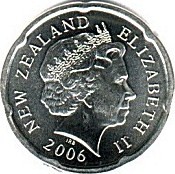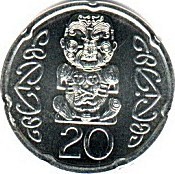The New Zealand dollar is the official currency and legal tender of New Zealand, the Cook Islands, Niue, the Ross Dependency, Tokelau, and a British territory, the Pitcairn Islands. Within New Zealand, it is almost always abbreviated with the dollar sign ($), with "NZ$" sometimes used to distinguish it from other dollar-denominated currencies.

The British florin, or two-shilling piece was a coin worth 1/10 of one pound, or 24 pence. It was issued from 1849 until 1967, with a final issue for collectors dated 1970. It was the last coin circulating immediately prior to decimalisation to be demonetised, in 1993, having for a quarter of a century circulated alongside the ten-pence piece, identical in specifications and value.

The lira was the currency of Italy between 1861 and 2002. It was first introduced by the Napoleonic Kingdom of Italy in 1807 at par with the French franc, and was subsequently adopted by the different states that would eventually form the Kingdom of Italy in 1861. It was subdivided into 100 centesimi, which means "hundredths" or "cents". The lira was also the currency of the Albanian Kingdom from 1941-1943.
Australian coins refers to the coins which are or were in use as Australian currency. During the early days of the colonies that formed Australia, foreign as well as British currency was used, but in 1910, a decade after federation, Australian coins were introduced. Australia used pounds, shillings and pence until 1966, when it adopted the decimal system with the Australian dollar divided into 100 cents. With the exception of the first Proclamation Coinage and the holey dollars, all Australian coins remain legal tender despite being withdrawn from circulation.

The Somaliland shilling is the official currency of the Republic of Somaliland.

The Jamaican dollar has been the currency of Jamaica since 1969. It is often abbreviated to J$, the J serving to distinguish it from other dollar-denominated currencies. It is divided into 100 cents, although cent denominations are no longer in use as of 2018. Goods and services may still be priced in cents, but cash transactions are now rounded to the nearest dollar.

The shilling is the currency of Kenya. It is divided into 100 cents.

The East African shilling was the sterling unit of account in British controlled areas of East Africa from 1921 until 1969. It was issued by the East African Currency Board. It is also the proposed name for a common currency that the East African Community plans to introduce.
The guilder or florin was the currency of the Netherlands from the 15th century until 2002, when it was replaced by the euro.

The pound was the currency of New Zealand from 1840 until 1967, when it was replaced by the New Zealand dollar. Like the pound sterling, it was subdivided into 20 shillings each of 12 pence.

The Rhodesian dollar was the currency of Rhodesia between 1970 and 1980. It was subdivided into 100 cents.
The coins of Canada are produced by the Royal Canadian Mint and denominated in Canadian dollars ($) and the subunit of dollars, cents (¢). An effigy of the reigning monarch always appears on the obverse of all coins. There are standard images which appear on the reverse, but there are also commemorative and numismatic issues with different images on the reverse.
Coins of the Australian dollar were introduced on 14 February 1966, although they did not at that time include the one-dollar or two-dollar coins. The dollar was equivalent in value to 10 shillings in the former currency.
The coins of the Fijian pound were part of the physical form of Fiji's historical currency, the Fijian pound.
The coins of the New Zealand dollar are used for the smallest physical currency available in New Zealand. The current denominations are ten cents, twenty cents, fifty cents, one dollar and two dollars. The $1 and $2 coins are minted in a gold colour, the 20c and 50c coins are silver colour and the 10c coin is plated in copper.
The New Zealand two-dollar coin is the largest-denomination coin of the New Zealand dollar. It was introduced along with the one-dollar coin in 1990. Both are made from an alloy of aluminium and brass. It is the largest and heaviest coin in circulation, weighing ten grams and measuring 26.5 millimetres in diameter. Its thickness is 2.7 mm, only 0.4 mm thinner than the one-dollar coin, thus it is the second-thickest coin in the country's circulation.
The New Zealand one-cent coin was the smallest denomination coin of the New Zealand dollar from the currency's introduction in 1967 to its demonetisation, along with the two-cent coin, on 30 April 1990. With a diameter of 17.53 millimetres, it is the smallest coin ever issued of the dollar, and at 2.07 grams in mass the lightest as well. Its reverse featured a fern leaf, a sign of New Zealand, associated also with its national rugby union team. The image was designed by Reginald George James Berry, who designed the reverses for all coins introduced that year.
The New Zealand fifty-cent coin is a coin of the New Zealand dollar. It was the largest by denomination, diameter and mass to have been introduced on the decimalisation of the currency on 10 July 1967, replacing the pre-decimal crown coin. A total of 81,585,200 pre-2006 50 cent coins were issued, with a total value of $40,792,600.00
The New Zealand ten-cent coin is the lowest-denomination coin of the New Zealand dollar. The 10-cent coin was introduced when the New Zealand dollar was introduced on 10 July 1967, replacing the New Zealand shilling coin. In 2006 its size was reduced as part of a revision of New Zealand's coins, which also saw its alloy become copper-plated steel.
The New Zealand two-cent coin was the second smallest denomination coin of the New Zealand dollar from the currency's introduction in 1967 to its demonetisation, along with the one-cent coin, on 30 April 1990. Its reverse featured two kowhai flowers, considered emblematic of New Zealand. The image was designed by Reginald George James Berry, who designed the reverses for all coins introduced that year.









